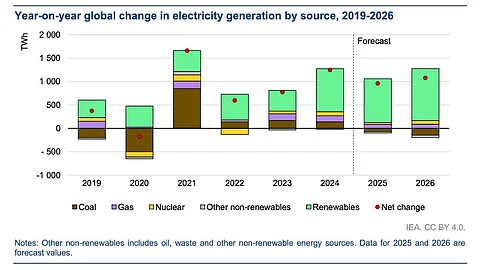

Solar and wind will meet over 90% of 2025’s electricity demand growth, according to the IEA
These power generation sources will likely push renewables ahead of coal as the leading global power source by 2025 or 2026
Power systems are under pressure from price variations, rising demand, and extreme weather, hence the need for more reliable and flexible electricity grids
Global electricity demand is set to grow 3.3% in 2025 and 3.7% in 2026, its fastest pace in over a decade, reports the International Energy Agency (IEA). Solar PV and wind are expected to cover over 90% of the increase in global electricity demand in 2025, pushing renewables past coal as the world’s top power source by 2025 or 2026. This shift, however, will depend on weather and fuel price trends.
In its Electricity Mid-Year Update 2025 report, the IEA forecasts coal’s share in the total generation to decline below 33% for the 1st time in a century within the forecast period of 2025-2026. Wind and solar PV will be central to this shift, as their combined share of global electricity generation will grow from 15% in 2024 to 17% in 2025, reaching close to 20% in 2026 – a 5-fold increase from 4% a decade ago.
The IEA expects wind and solar PV generation to surpass 5,000 TWh in 2025 and 6,000 TWh in 2026. Together, both these technologies are projected to provide almost an additional 1,000 TWh in 2026, roughly equivalent to the annual electricity consumption of Japan.
Currently, the largest source of renewable electricity supply globally, with a 14% share, hydropower will remain relatively flat this year, owing to droughts in various regions in H1 2025. Pending normal hydrological conditions, the IEA expects hydropower generation to rebound by more than 2% next year.
Among other power generation sources, nuclear power output will also rise to record highs, thanks to growth in Japan, the US, and France, as well as new additions in Asia. Coal’s momentum is also curbed by gas-fired power generation, which the IEA says will continue to displace coal and oil in the power sector in many regions.
Regional Spread
As per the IEA report, the lion’s share of the global electricity demand growth will come from China and India, which are expected to account for 60% of the increase in global electricity consumption over 2025 and 2026. The rapid expansion of data centers will also ensure an over 2% increase in annual electricity demand growth in the US in both 2025 and 2026.
In China, solar PV and wind generation are forecast to grow by 27% and 19%, respectively. For the US market, the IEA sees renewables expanding at around 10% in 2025 and 7.5% in 2026, despite policy headwinds. Solar PV is expected to lead this expansion, with growth of 26% in 2025 and 18% in 2026, making it the largest contributor to new power generation.
The European Union (EU) will see slower growth in electricity consumption this year at around 1%, followed by a modest acceleration in 2026.
“The strong expansion of renewables and nuclear is steadily reshaping electricity markets in many regions. But this must be matched by greater investment in grids, storage and other sources of flexibility to ensure power systems can meet the growing demand securely and affordably,” stressed IEA Director of Energy Markets and Security, Keisuke Sadamori.
During H1 2025, wholesale electricity prices rose by 30% to 40% in the EU and US due to higher gas prices, but dropped by 5% to 15% in India and Australia. At the same time, negative electricity prices became more common in Europe, showing a growing need for flexible energy systems like storage and demand response.
The report writers recommend a look at the cost differences across different regions, which can have implications for the industrial sectors. For instance, the average electricity prices for energy-intensive industries in the EU are still double those in the US and significantly higher than in China. “These cost differences continue to pose challenges to the competitiveness of energy-intensive industries in the European Union,” they stress.
The report lists recent major blackouts in Chile, Spain, and Portugal to show the significance of a secure and reliable power supply. As electricity use grows and systems get more complex, strong grids, stable supply chains, and updated rules are needed to avoid outages and keep power flowing, reads the report.
The complete report is available for free download on the IEA’s website.
